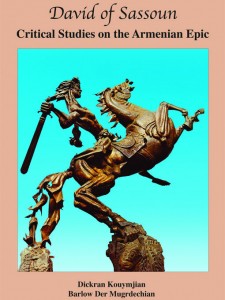Staff Report

David of Sassoun: Critical Studies on the Armenian Epic (The Press at California State University, Fresno, 2013), 228 pages, a collection of essays by the world’s foremost scholars on the great oral epic of Armenia, edited by Dickran Kouymjian and Barlow Der Mugrdechian, has just been published as the newest addition to the Armenian Series of Fresno State’s Armenian Studies Program. David of Sassoun is the fourth title in the Armenian Series established through The Press at California State University, Fresno.
The essays, by Charles Dowsett, Dickran Kouymjian, Aram Ter-Ghevondian, Earl R. Anderson, Chaké Der Melkonian-Minassian, Frédéric Feydit, Arpiné Khatchadourian, Aram Tolegian, Chaké Der Melkonian-Minassian, Vahé Oshagan, as well as an original poem on David by Ashough Hovnani, were presented at a Symposium organized by Dr. Kouymjian the year after he was invited to the campus to establish a new Program devoted to Armenian Studies. He saw it as Fresno’s contribution to the commemoration of the centennial celebration of the discovery and publication of the epic poem, which had survived until the 1970s orally, passed on, generation after generation, for more than a thousand years by anonymous village bards.
The Symposium was planned to coincide with the world premier of a new opera by one of America’s most well known and liked composers, Earl Robinson, best known for his cantata Ballad for Americans made famous by Paul Robeson in 1939, and such songs as “Joe Hill,” “The House I Live In,” and a number of Hollywood film scores.
Robinson’s opera, “David of Sassoun,” was inspired in the early 1970s when he was in Fresno on a visit from his home in Santa Barbara. He was struck by the power of the enormous bronze equestrian statue of David of Sassoun in Courthouse Park in downtown Fresno. He located the artist, Varaz Samuelian (1917-1995), a close friend of William Saroyan and a native of Erevan, Armenia, who after the Second World War worked in the atelier of Fernand Léger in Paris, before finally settling in Fresno.
Samuelian carefully explained the history of the statue and the heroic details of the saga of Sassoun.
Robinson was intrigued. After careful research, he spent several years writing the opera. Its premier was scheduled at California State University, Fresno, while Robinson was on campus as composer in residence. In the original working scenario, the opera is subtitled “A Folk Opera, a Musical Legend, a Pageant, a Fairytale…,” and is divided into three acts each with twelve scenes. The World Premier was director by Professor Ed EmanuEl of the Fresno State Theatre Arts Department and held in the University Theatre the night before the Symposium.
Every serious scholar from Armenia, France, England, Canada, and the United States who had published on the Armenian epic was invited to participate in the International Symposium entitled “David of Sassoun: The Armenian Folk Epic after a Century.” The all day Symposium took place in the vast main floor of the old Student Union to an overflow crowd. In addition to the papers of the conference, the current volume contains an introduction outlining the history of the epic as well as a concise summary of all the episodes of the official version established by a team of scholars in Erevan in 1939. The essays are as fresh today as they were when they were written despite the decades, which have passed.
Also included at the beginning of the volume is a new variant, the only known version of the epic recorded anywhere in the Diaspora. Because of the publicity generated by the Symposium, Lilyan Chooljian of Fresno, present at the conference, who had recorded a recitation of the variant some years earlier, brought it to the attention of Dr. Kouymjian.
Thanks to a generous grant from the Dolores Zohrab Liebmann Fund and the M. Victoria Karagozian Kazan and Henry S. Khanzadian Kazan Fund, and the efforts of Professor Der Mugrdechian to include the volume in the Armenian Series of monographs the Program sponsors, the book is now available to the general public.
The critical brilliance of many of the essays, at times challenging traditional views held on the epic and how it should be presented and understood, will provide much source material for scholars.
David of Sassoun: Critical Studies on the Armenian Epic is available from The Press at California State University, Fresno through its website http://shop.thepressatcsufresno.com/, by post at The Press at California State University, Fresno, 2380 East Keats Avenue M/S MB 99, Fresno, CA 93740-8024, or by calling 559-278-3056.
 Hye Sharzhoom Armenian Action
Hye Sharzhoom Armenian Action